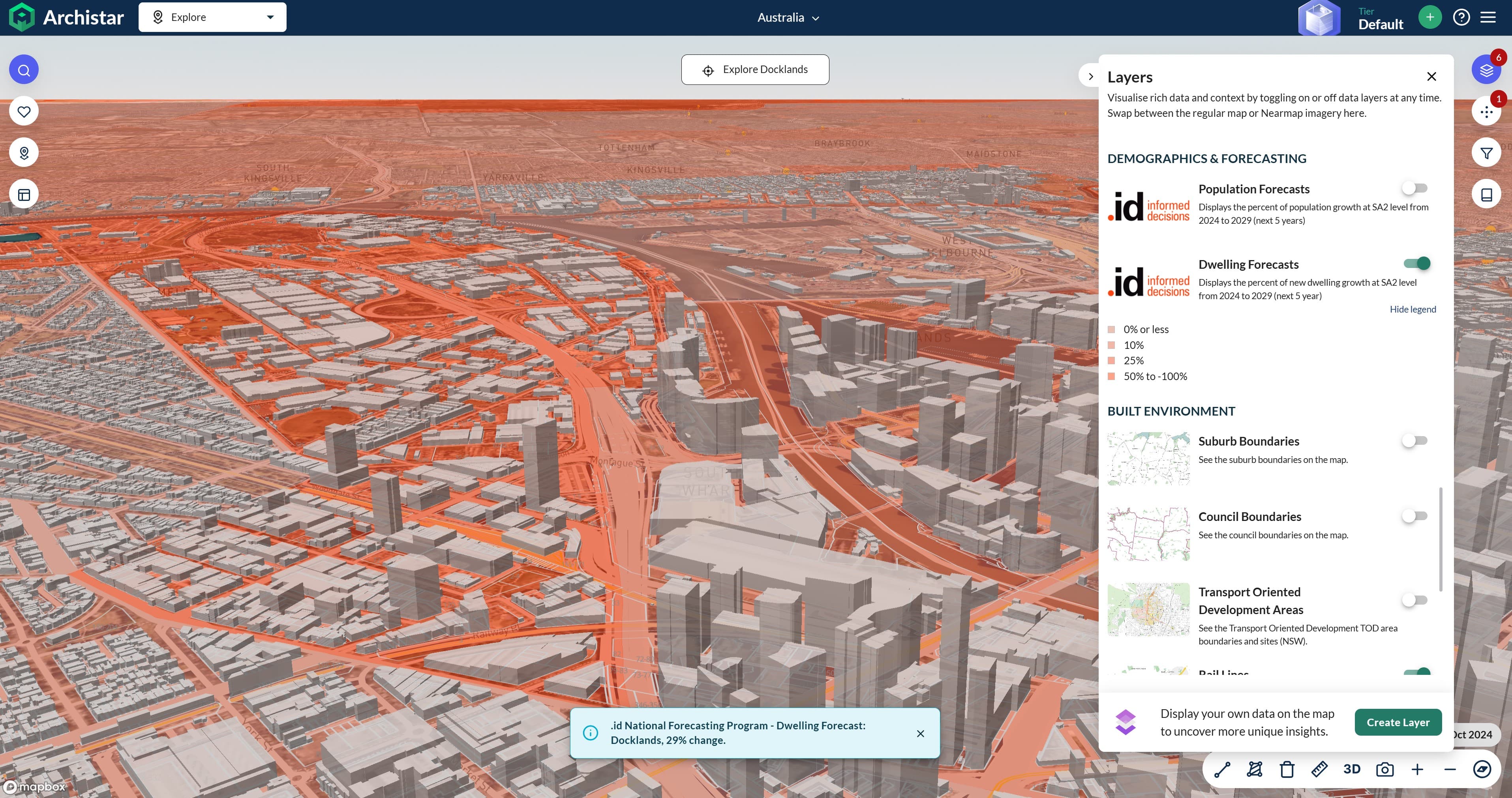BLOG
The population forecast for New South Wales
The population forecast for New South Wales
New South Wales is Australia’s most populated state, with just under a third of the national population residing in NSW. The disruptions of the COVID pandemic had a significant impact on the state, with a net loss of people through overseas and internal migration. With the borders reopening, NSW saw a spike in overseas arrivals.
But our most recent forecast shows a stabilisation in overseas migration and a return to previous patterns in population growth and movement for the state.
Our national forecast predicts an additional 9.2 million people in Australia heading towards 2046. Over a quarter of those people are expected to be in NSW – that’s an extra 2.4 million people in the state and a total population of 10.5 million by 2046.
Where will these new people live?
In this article, we explore NSW’s projected population growth leading up to 2046. We look at the share of growth across metropolitan and regional NSW, and reveal insights into the impact of housing supply on the population forecast.
This blog shares a recap of the big stories from our recent presentation of our latest forecasts for NSW and the ACT. Visit the webinar resources page to re-watch the presentation on-demand, or for a copy of the presentation slides or a short recap video.
The picture of national population growth
Our national population forecast indicates that Australia’s population will reach just under 35 million people by 2046. That’s an extra 9.2 million people.
Each year, our population’s natural increase (net of births and deaths) adds an extra 100,000 people. This should remain steady over the next quarter-century.
The other, and much larger, contributor to our national population is net overseas migration.
During the COVID pandemic, Australia experienced a net loss in overseas migration. More people left than came home.
In the last two years, this has reversed. We have experienced significant net gains from overseas migration. In 2022-23, arrivals increased 73% and we had a net gain of over half a million people. The Department of Immigration and the ABS agree this is due to a “catch up effect” after international borders reopened. Long term we expect net overseas migration to stabilise, returning to similar levels experienced pre-COVID.
Our long-term assumption is that Australia will continue to see a net gain of 235,000 people from overseas each year.
This is in line with the best information from the government, including last year’s intergenerational report, the latest federal budget papers, and the intended effects of the migration strategy announced in December.
What will be NSW’s share of national population growth?
One of the big stories from our national population forecast is the return to the cities. We expect that the four largest states – New South Wales, Victoria, Queensland and Western Australia – will account for 93% of Australia’s forecast growth.
Within those states, two-thirds of our national growth is forecast to happen in Sydney, Melbourne, Brisbane and Perth.
So how much of this growth will take place in NSW?
Historically, NSW has accounted for around 25% of Australia’s growth. We see that share of national growth continuing forward to 2046.
The graph below reveals insights into the forecasted population growth and movement patterns for NSW:

- Natural increase (the green line) is still adding people, but its contribution is declining overtime. This mirrors the experience at a national level
- Overseas migration (the blue line) is a strong contributor. The state is the first port of call for many people arriving in Australia
- Interstate migration (the orange line) also plays a role. NSW has a well-established pattern of losing people to other states (especially Queensland). This slightly offsets the gains from overseas migration.
NSW typically loses younger families and retirees to other states. We also see young adults moving to other large cities like Melbourne for work and study.
Greater Sydney – where are the growth hot spots?
The lion’s share of the state’s population growth will be concentrated in Greater Sydney.

Forecast population growth across NSW, highlighting the growth hotspots in Great Sydney
When we break down Greater Sydney, we can see different growth stories for each area. See the presentation slides for a more detailed analysis of each region, or subscribe to updates from our National Forecasting Program to be notified when new forecasts are published for an area of interest to you.
City and Southern Sydney
- The share of population growth is tapering off, with constraints on new housing supply and major development projects
- But there are opportunities for densification, which will see it still account for 17% of NSW population growth
Northern Sydney
- Over time Northern Sydney will attract a smaller share of overall population growth
- The urban footprint is well established but there are opportunities for growth in major centres like Hornsby and Macquarie Park
- The new metro line through Crow’s Nest will also support additional growth
Parramatta
- Source of major developments and brownfield opportunities
- Growth is likely to be concentrated along the M4 Western Motorway and rail corridor
- Future light rail infrastructure will support more growth
South West Sydney
- Likely to experience net gains from internal migration within Greater Sydney, as people move out from the City and Southern Sydney seeking more affordable housing
- The primary source for greenfield growth, seeing it gain nearly half a million people by 2046
- Looks to attract 16% of the state’s forecast population growth
North West Sydney
- Another key growth area, attracting 17% of NSW’s population growth
- The younger population sees births make a large contribution to population growth
- Internal and overseas migration still play a role in the area’s growth
- Source of greenfield developments, although there are natural constraints from the Hawkesbury Basin and Blue Mountains
What is regional NSW’s share of the population growth?
Regional NSW is expected to attract around 27% of the population growth for the state. This builds on the regional growth patterns we were seeing pre-pandemic, with places like the Hunter, Central Coast and Illawarra increasing their share of the state’s growth.
Let’s look at the story for each of the regional areas.
Hunter Central Coast
- Attracts internal migration from across Greater Sydney, especially the northern areas
- Restrictions around Newcastle see opportunities for greenfield developments in the Hunter Valley
- Expected to account for 11% of NSW’s total population growth over the next twenty-five years
Illawarra and South Coast
- Overseas migration is a significant driver of growth, but natural increase and internal migration also make a contribution
- Lots of land identified for future development and strong greenfield opportunities
North Coast – New England
- Reliant on migration for growth given older population, and there is plenty of land to support an increased population
- Notable loss of population to the Gold Coast
Riverina-Murray and the Central Far-West
- Both regions tend to lose young people to larger cities, but births and overseas migration growth rates are expected to remain steady
- Plenty of land available to support population growth
The second piece of the puzzle: Housing supply
What we have looked at so far is the demand side of population growth – the demographics associated with births, deaths and migration.
The other part of the equation is housing supply – where will housing be available for the additional population to live?
Just considering the demand side risks over-populating certain areas where demand outweighs supply. But looking closely at current and future housing supply ensures we only forecast as much growth as an area can actually accommodate.
This produces a much richer and more accurate picture of not just where our future population will live, but when the growth will happen in specific areas, right down to a city block. This level of granularity is important when trying to understand the nuances of where growth is forecast to occur.
Matching housing supply with population demand has revealed a few key themes around how housing is impacting the population forecast for NSW:
- State government planning controls will impact where in the state there are more opportunities to increase capacity, while local planning controls can impact opportunities for densification within existing suburbs. As state governments and local governments respond to the impacts and risks associated with climate change, we expect planning controls to have more influence on housing supply. For example, the NSW government has made a commitment to reduce housing developments on high-risk flood plains, materially impacting the supply of housing available in the future.
- Infrastructure projects and major developments will drive the spread of population growth across the regions of NSW. Major projects that we have accounted for in our forecast include the Bankstown metro rail conversion, the Western Sydney Aerotropolis and the Parramatta light rail.
- The housing supply chain is struggling with shortages of skilled labour and building materials and a decline in finance and investment growth.
- Housing affordability is likely to continue having a significant impact on population movements, pushing more people out from metropolitan Sydney. Regional areas that are experiencing population growth now are starting to feel the pressure of rising house prices, and this will have an impact on internal migration around the state in the future
How these themes impact the population outlook is very specific for each local area. Our team is currently working through the NSW local area forecasts to provide more granular insights into how the NSW population growth will translate into each local area. Subscribe here to be notified as our local area forecasts are released.
Summary
The population growth forecast for New South Wales points to a stabilisation and return to ‘regular programming’ after the disruption of the COVID pandemic. The state will continue to attract around one-quarter of national population growth, with the majority (75%) of these new people forecast to live in Greater Sydney.
Within Greater Sydney, capacity and affordability constraints in the inner city will push population growth out to the North West and South West areas. Major transport infrastructure developments will support this spread.
Looking further out, the Hunter Central Coast and Illawarra South Coast offer lots of opportunities for greenfield developments and will continue to experience solid regional population growth.
If you are interested in more detailed information about a specific area, sign up to receive updates on when we publish new local area forecasts. You can also visit our national launch page to access the full webinar and presentation covering Australia’s national population forecast and the return to the cities.
If you’re searching New South Wales to inform a location, planning or investment decision, learn more here about the different ways you can access detailed and trusted forecasts of population, housing and development, to help you invest in the right place, at the right time.
Also published on Medium.









